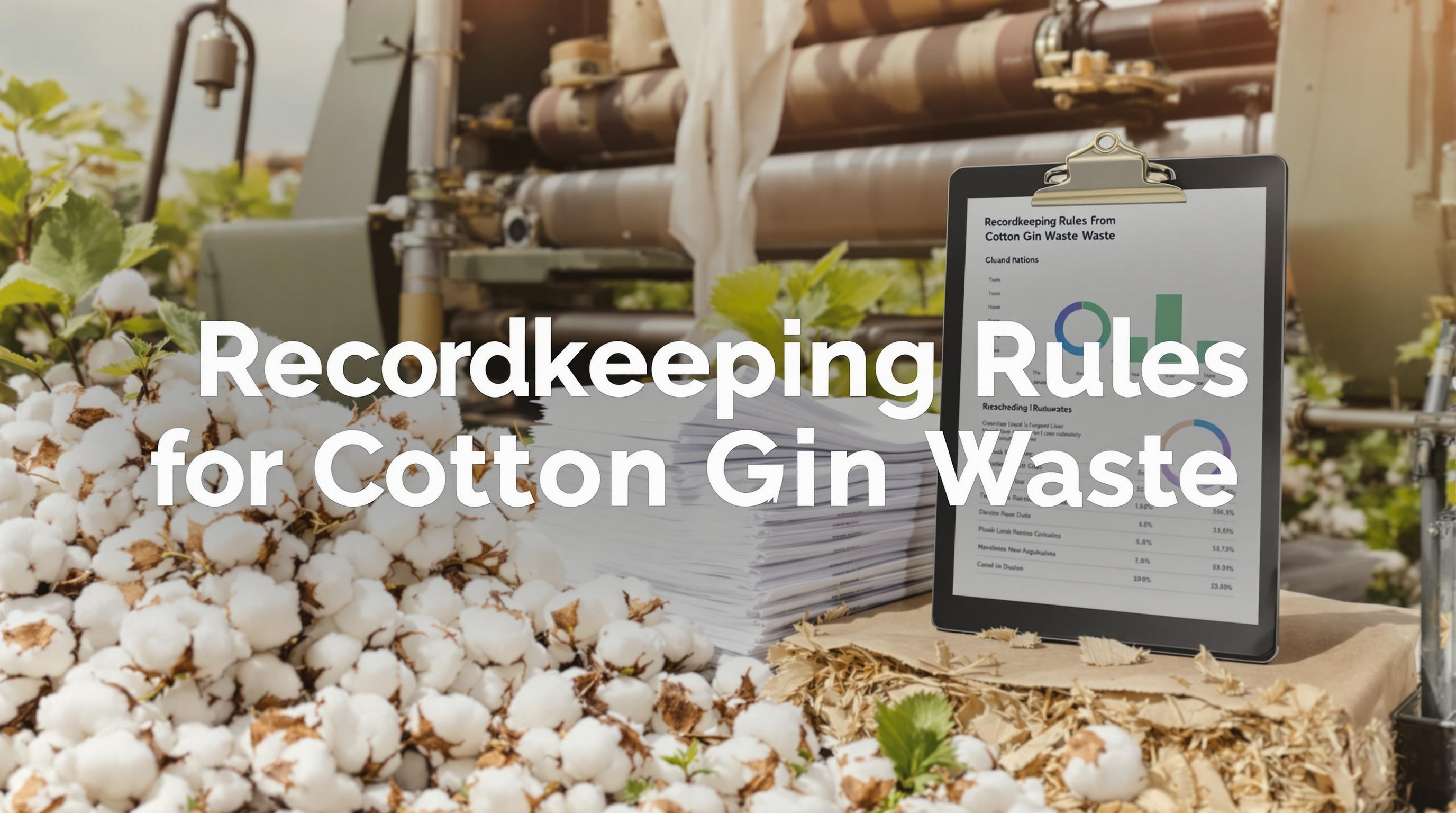Cotton farming is risky. Unpredictable weather, rising costs, and climate challenges often lead to crop failures, leaving farmers financially vulnerable. Crop insurance offers a financial safety net, helping farmers recover from losses and stay operational.
Key Takeaways:
- Risks in Cotton Farming: Extreme weather, droughts, and floods can devastate yields, while fixed costs like equipment payments and land leases remain unchanged.
- Insurance Options: U.S. farmers can access federal programs like Revenue Protection (RP), Actual Production History (APH), Supplemental Coverage Option (SCO), and Stacked Income Protection Plan (STAX). Each has unique features for managing losses.
- Financial Impact: Insured farmers can maintain cash flow and credit during tough seasons, while uninsured farmers often face severe financial strain, leading to asset sales or debt accumulation.
- Government Support: Subsidies make crop insurance more affordable, covering 38%-80% of premiums. Additional benefits are available for beginning, veteran, and socially disadvantaged farmers.
Farmers must weigh the cost of premiums against the potential financial relief insurance provides. While not perfect, crop insurance ensures stability in a highly unpredictable industry.
Agricultural Risk Management • In Our Expert Opinion Podcast
Crop Insurance Options for Cotton Farmers
Cotton farmers in the U.S. can rely on federal crop insurance programs to cushion financial losses caused by crop failures. These programs, managed by the Risk Management Agency (RMA), offer various coverage levels and strategies to help farmers stay financially stable, especially when faced with unpredictable weather.
Over time, crop insurance options for cotton have become more refined, addressing the unique challenges of cotton farming. Knowing these options is essential for making smart decisions about risk management and financial planning. Here’s a breakdown of the key federal programs available to cotton farmers.
Available Insurance Programs
Revenue Protection (RP) is a popular choice, covering yield losses and price drops based on either the spring or harvest price. Farmers can select coverage levels ranging from 50% to 85%, with most opting for 70% to 80%. This program covers about 85% of insured cotton acres across the country.
The Actual Production History (APH) program focuses solely on yield protection, without addressing revenue risks. While it’s less extensive than RP, it’s often a more affordable option for farmers who manage price risks separately.
For those needing additional protection, the Supplemental Coverage Option (SCO) offers extra coverage. SCO helps cover part of the deductible in a farmer’s main crop insurance policy, with payments triggered when county yields fall below 86% of expected levels.
The Stacked Income Protection Plan (STAX) is tailored specifically for cotton farmers. It provides area-based coverage for shallow losses - smaller revenue declines at the county level that don’t activate individual farm policies but can still hurt profitability. Farmers can choose coverage levels ranging from 10% to 30% of expected county revenue, with options to cover 70% to 90% of county revenue.
Whole-Farm Revenue Protection (WFRP) is designed for farms that grow cotton alongside other crops. Instead of insuring individual crops, WFRP covers the revenue of the entire operation. This makes it a great option for farmers who rotate cotton with other crops or run diverse agricultural businesses.
Qualification Requirements and Government Support
To qualify for these programs, farmers must have at least four years of production history (or alternative data for newer farmers), follow Good Farming Practices, and implement conservation measures on sensitive lands.
Premium subsidies play a major role in making these programs affordable. Depending on the selected coverage level, subsidies can reduce costs by 38% to 80%. For instance, farmers choosing 50% coverage receive an 80% subsidy, while those opting for 85% coverage get a 38% subsidy.
Beginning farmers, veterans, and socially disadvantaged farmers receive additional benefits, such as higher premium subsidies and lower administrative fees. These measures aim to support groups that often face extra challenges in building and maintaining successful farming operations.
To keep the programs running smoothly, the government reimburses operating expenses and provides reinsurance to protect against catastrophic losses. This ensures the programs remain financially stable while keeping premiums within reach for farmers.
Farmers must enroll through approved insurance agents, who guide them in selecting the right coverage and understanding policy details. Applications are typically due by February 28th (though dates vary by state), with premiums due by October 31st. Agents help ensure farmers meet these deadlines and choose the best options for their needs.
Financial Results: Insured vs. Uninsured Cotton Farms
This section dives into the financial outcomes for cotton farms with and without crop insurance. When cotton farms face crop failures, the financial consequences can take two very different paths. Farmers with insurance can soften the blow, while those without it often face the full force of the loss, threatening their ability to continue operating.
Financial Impact Without Insurance
For uninsured cotton farmers, crop failures can be financially devastating. Without insurance, they absorb the entire loss from reduced or failed yields. This means a sharp drop in income, but their financial responsibilities - like loan payments, equipment maintenance, and land leases - don’t go away. The resulting cash flow problems can lead to tough choices, such as selling off assets or cutting back on operations. Over time, this can create a cycle of increasing debt and ongoing financial pressure, making it harder to recover.
How Insurance Reduces Financial Losses
Crop insurance acts as a safety net, turning what could be catastrophic losses into manageable challenges. By covering a significant portion of expected revenue, insurance ensures that farmers receive compensation even when bad weather slashes their yields. Subsidized premiums make this protection more accessible, strengthening risk management efforts.
Fast claims processing provides farmers with much-needed cash flow during critical times, helping them cover expenses without resorting to emergency loans or selling off assets. Additionally, having crop insurance improves a farmer’s standing with lenders, as it’s seen as a solid risk management tool. This can open doors to better credit terms and contribute to long-term financial stability. In short, insurance provides a financial buffer that clearly distinguishes insured farms from those operating without coverage.
Comparing Insured and Uninsured Operations
The contrast between insured and uninsured cotton farms is most visible in their ability to maintain cash flow and safeguard their assets. Farmers with insurance are better equipped to reinvest in their operations, purchasing inputs for the next season and keeping their businesses on track. On the other hand, uninsured farms may struggle to secure the funds needed to stay competitive, putting their future at risk.
While crop insurance isn’t a cure-all, it’s a key tool for reducing the risks associated with cotton farming, making it a more stable and sustainable business venture.
sbb-itb-0e617ca
Crop Insurance Benefits and Drawbacks
For cotton farmers, weighing the benefits and challenges of crop insurance is essential to balance short-term relief with long-term financial goals.
Advantages of Crop Insurance
Crop insurance offers a financial safety net by providing timely compensation for losses caused by severe weather or other covered risks. This helps farmers maintain cash flow and ensures their operations remain viable, even during tough times.
Federal subsidies play a big role in making crop insurance more affordable. For cotton farmers, who often face high costs for equipment, land, and production inputs, these subsidies ease the financial strain.
There are also policies specifically designed for cotton growers. For example, revenue protection policies cover both yield losses and price fluctuations, giving farmers added security against unpredictable production and market conditions.
Problems with Crop Insurance
Despite its benefits, crop insurance comes with its own set of challenges. Premium payments, even with subsidies, can still place a financial burden on farmers, especially those with tight budgets.
Standard policies often fall short of covering every type of loss. For instance, a drop in crop quality that impacts market value might not be fully covered, leaving farmers to absorb part of the loss.
The complexity of insurance policies is another issue. Farmers need to understand coverage levels, exclusions, and conditions, which can be time-consuming and may lead to unintended gaps in protection.
Some critics argue that heavy reliance on insurance payouts could discourage farmers from adopting robust risk management practices. Additionally, the administrative side - like keeping detailed records and meeting reporting requirements - can pull time and resources away from farming.
There’s also concern about how subsidies and guaranteed payments might influence farming decisions. These incentives could lead to shifts in planting choices or land use patterns, potentially distorting markets. Over-reliance on crop insurance might also deter farmers from exploring alternative ways to manage risks, which could have implications for the industry’s long-term stability.
Understanding these challenges is crucial for evaluating crop insurance as part of broader agricultural strategies.
Agricultural Policy and Cotton Industry Stability
Agricultural policies play a crucial role in ensuring the long-term stability of the cotton industry. While crop insurance provides immediate financial relief, government policies shape how farmers access this insurance and maintain a steady foundation for the industry.
Key U.S. Agricultural Policies
One of the most important tools for supporting cotton farmers is the Federal Crop Insurance Program (FCIP), managed by the USDA Risk Management Agency. This program ensures that cotton farmers can access crop insurance at reasonable rates, helping them navigate the financial challenges of crop failures and volatile market conditions.
Strengthening Industry Stability
By making insurance more affordable, federal policies help create a more predictable income stream for farmers, which in turn stabilizes the broader cotton industry. This stability extends beyond individual growers, supporting the entire supply chain - from farm operations to critical infrastructure like cotton gins. A reliable network of cotton gins, as highlighted on cottongins.org, is essential for efficient cotton processing and sustaining local agricultural communities.
Conclusion: Weighing Financial Risks Against Insurance Benefits
Cotton farmers face a tough choice: absorb the full brunt of potential losses or invest in crop insurance. Without insurance, extreme weather or pest infestations can devastate operations, often forcing farmers to sell assets, take on more debt, or even leave the industry altogether.
Crop insurance, on the other hand, provides a safety net by covering a large share of production losses. This protection helps maintain cash flow and credit, enabling farmers to keep their operations running even during difficult seasons. Government support plays a key role here, bolstering not just individual farms but also the agricultural supply chain as a whole. This financial stability is further reinforced by strong local agricultural networks.
Local networks also play a critical role in supporting cotton farmers. Connecting with these networks can provide access to essential resources and infrastructure. For example, platforms like cottongins.org help farmers locate nearby cotton gins and explore networking opportunities. This can be especially valuable during challenging times when farmers need to quickly process salvaged crops or find alternative solutions.
FAQs
How do federal crop insurance programs support new, veteran, and underserved cotton farmers?
Federal crop insurance programs offer focused assistance to new, veteran, and underserved cotton farmers, helping them navigate the financial challenges that come with crop failures. These programs provide benefits like premium subsidies, relaxed eligibility criteria, and extra support to make insurance options both accessible and affordable.
With these tailored measures, the programs work to bolster the financial resilience of farmers who are starting their journey, transitioning from military service, or facing social disadvantages. This kind of support ensures they have the tools needed to recover from setbacks and establish a stable farming operation.
What’s the difference between Revenue Protection (RP) and Actual Production History (APH) insurance for cotton farmers?
Revenue Protection (RP) insurance offers cotton farmers a safety net against two major risks: price drops and yield reductions. By calculating a revenue guarantee based on projected market prices and expected yields, it ensures farmers have a financial cushion if either market conditions or production levels fall short.
On the other hand, Actual Production History (APH) insurance zeroes in on yield losses caused by natural disasters like drought or severe storms. Unlike RP, APH doesn’t consider market price fluctuations, focusing solely on protecting farmers from production-related setbacks.
RP stands out for its broader coverage, addressing both price and yield uncertainties. Meanwhile, APH is a straightforward option for farmers who are primarily concerned about safeguarding their crops from natural disasters.
How does crop insurance help cotton farmers manage financial risks and ensure long-term stability?
Crop insurance serves as a vital safety net for cotton farmers, helping them navigate financial risks tied to unpredictable events like extreme weather, pest outbreaks, or shifts in the market. By cushioning the blow of crop failures, it eases financial pressures and enables farmers to bounce back faster, ensuring their operations stay on track.
In the long run, this kind of protection contributes to greater stability by reducing uncertainty and supporting resilience. When paired with other risk management strategies, crop insurance allows cotton farmers to concentrate on sustainable growth and the future of their farms. Federal crop insurance programs, in particular, are structured to help farmers build a stronger financial foundation for their operations.


